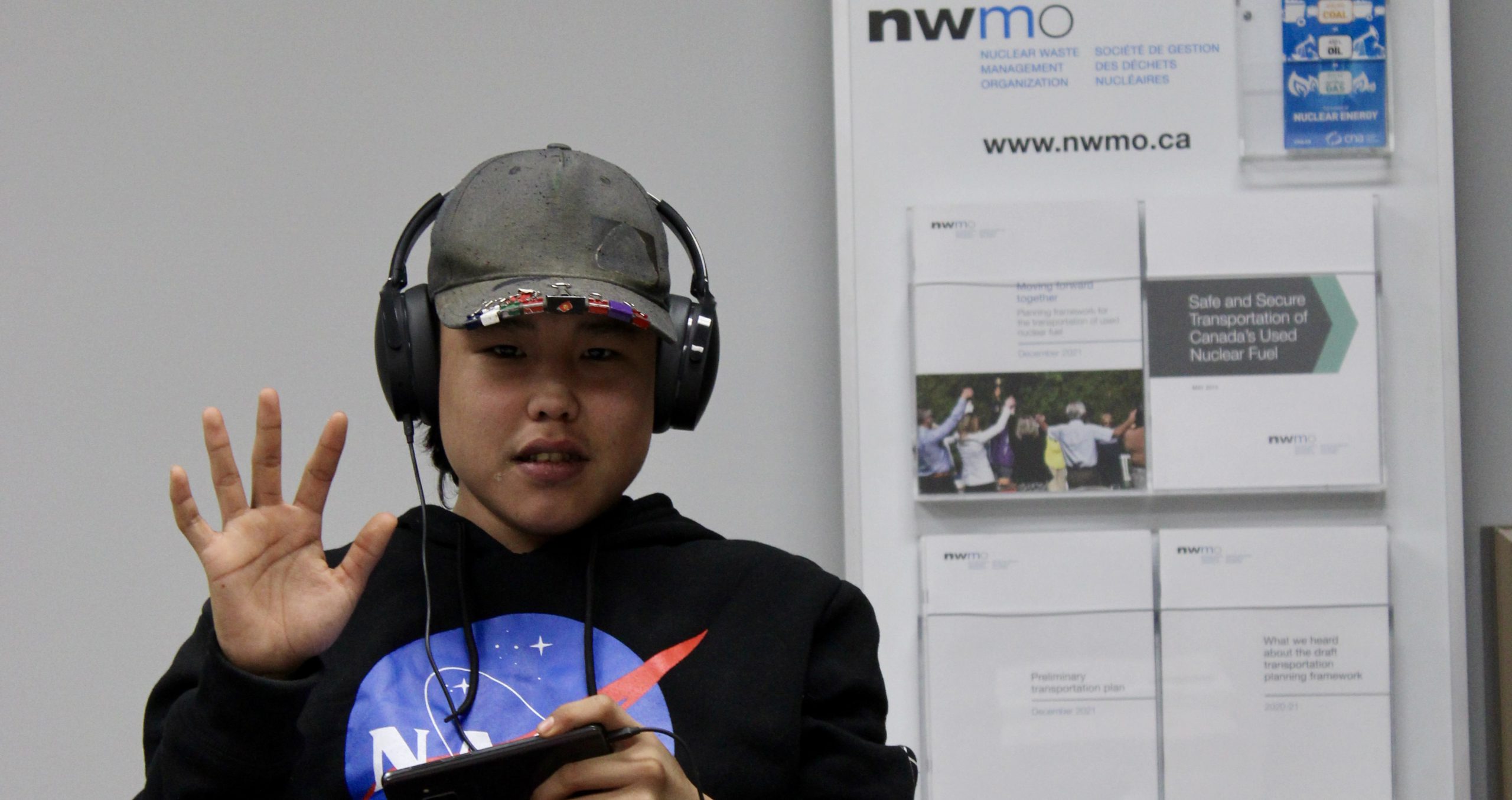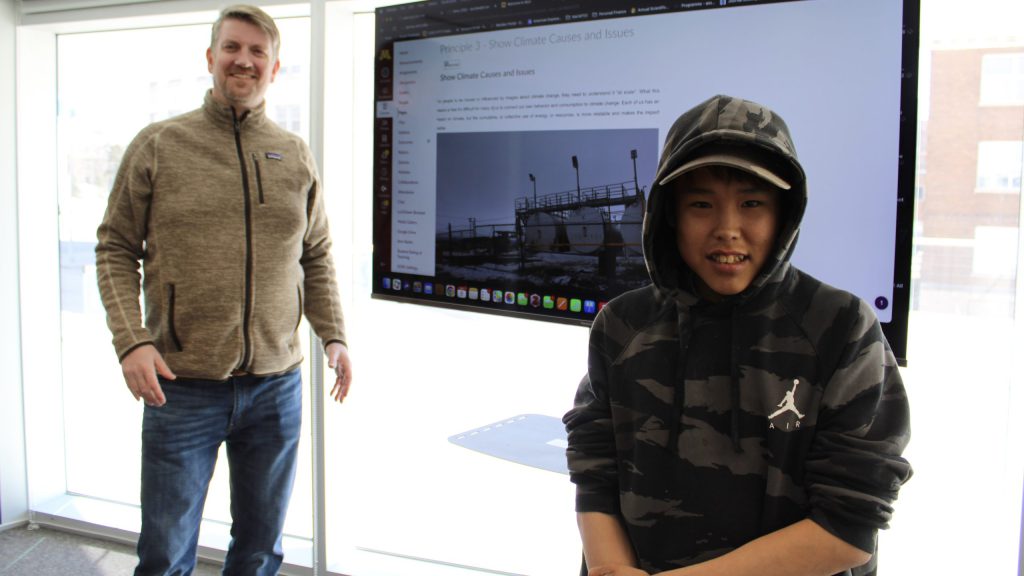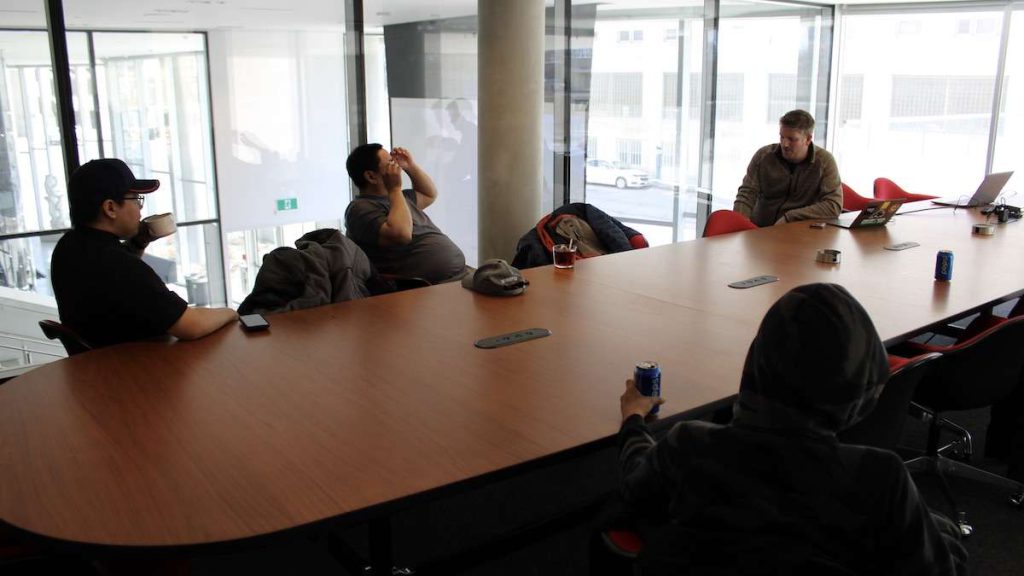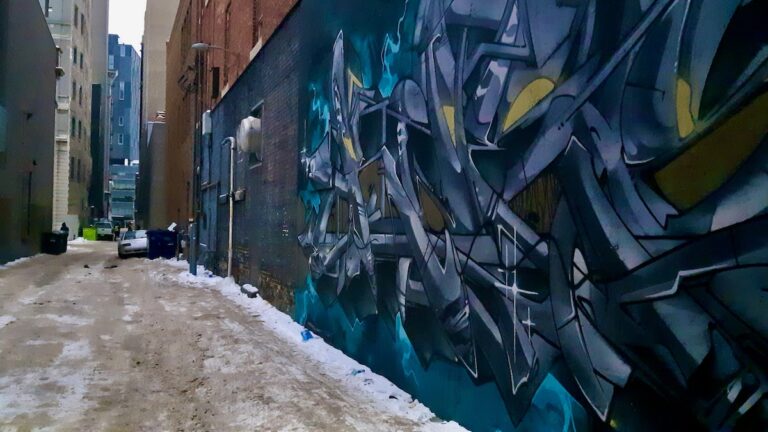
Tony Eetak is one of the youth artists involved in establishing The Arts Incubator.
A Deep Dive into The Arts Incubator’s Initiatives with the Art Borups Corners Collective
I. Executive Summary
The Arts Incubator, a dynamic and evolving network of artists, projects, and collectives, stands as a pivotal force in advancing creativity, community arts programming, and cultural innovation. Its foundation was strategically supported by the Canada Council for the Arts Digital Greenhouse, underscoring a profound commitment to digital transformation.[1] The organization’s digital arts and cultural entrepreneurship incubator fosters a supportive community of practice and care, built on collaboration and shared purpose.[1] Community infrastructure and programs were severely disadvantaged by flooding, which compromised much of the Northwestern Ontario-based hub’s activities, leading to more than two years of setbacks and expensive reconstruction and restoration of capability and capacity.
Significant strides have been made in developing advanced digital infrastructure and capacity within the arts and recreation sectors, particularly through the initiatives at Art Borups Corners. These innovations are specifically designed to empower artists, streamline administrative processes, and enhance community operations.[2], [3], [4], [5], [6]
A core focus involves building robust digital arts infrastructure and cultivating digital skills among artists, especially those residing in small, rural, and northern communities. This directly addresses critical needs such as administrative burdens and communication challenges prevalent in these regions.[4] The ongoing renovation of the Arts Incubator’s website further exemplifies its dedication to an improved digital presence and enhanced user experience.[2], [7]
The initiatives undertaken by The Arts Incubator at Art Borups Corners directly confront the “digital disconnect” and “archaic mindsets” that often impede vital arts, culture, and recreation programs in many Northern communities.[7], [8] Furthermore, this work aligns seamlessly with the Framework for Recreation in Canada, contributing to enhanced recreation capacity, addressing workforce shortages, fostering youth leadership, and promoting innovative program delivery through the strategic application of technology.[9]

II. Introduction: The Arts Incubator’s Digital Mandate
Context: Addressing Digital Gaps in Northern Communities
Many Northern communities increasingly face significant challenges stemming from a pervasive “digital disconnect” and, in some instances, a resistance to adopting modern digital tools. This situation creates substantial barriers to vital arts, culture, and recreation programs, leading to a deeper sense of community isolation.[7], [8] The consequences of this digital void are far-reaching, impacting every facet of an arts or community organization’s operations. Communication with touring artists, potential funders, or collaborating with other arts or cultural institutions can be sporadic or non-existent without reliable internet access. Furthermore, record-keeping often relies on outdated paper or offline ledgers, rendering financial oversight cumbersome and susceptible to errors.[8]
Beyond the fundamental absence of basic internet capabilities, many northern arts organizations grapple with a profound lack of modern digital tools and the human capacity to use them. This inability, or sometimes unwillingness, to leverage even basic digital platforms severely restricts outreach and public engagement. Without a functional website, online forms, or a social media presence, community groups can become effectively invisible to a large segment of the population, particularly younger generations. This digital isolation stifles crucial community engagement, making it difficult for artists and culture sector workers to access information, provide feedback, or even discover available services. Critically, this digital deficit leaves northern arts and recreation organizations profoundly unprepared for future demands, as regulatory changes, evolving community needs, and even basic communication can be severely hampered without foundational digital elements.[8] A significant contributor to this stagnation is often an archaic mindset, a lack of digital literacy, particularly among leadership, reflecting a lack of awareness about the critical need to learn, adapt, and grow in a rapidly evolving digital world.[8]
The strategic adoption of digital solutions directly addresses the systemic digital poverty, social isolation and disintegration and cultural resistance to change observed in these regions. By investing in and promoting digital literacy and technological integration, organizations can overcome existing deficiencies. This approach highlights a clear path where targeted funding and a proactive organizational vision can directly counter the identified challenges.

The Arts Incubator’s Genesis and Vision: Seeded by Canada Council for the Arts Digital Greenhouse
The Arts Incubator was established with strategic arts innovation funding from the Canada Council for the Arts Digital Greenhouse.[1] This foundational support enabled the organization to focus on leveraging digital technology to address sectoral challenges and develop innovative models within the arts and culture landscape. The organization’s vision is to cultivate a “dynamic and evolving network of artists, incubator projects, and collectives dedicated to advancing creativity, community arts programming, and cultural innovation”.[1]
A core commitment of The Arts Incubator involves “exploring the intersection of art, culture, resilience, and digital innovation, creating a space where creative expression becomes a catalyst for individual and collective transformation”.[1] This commitment extends to fostering creative leadership and connection, with a particular emphasis on empowering Indigenous youth through digital storytelling and AI tools. The program aims to bridge traditional knowledge with modern technologies, fostering new avenues for artistic expression and community building.[3], [9]
The digital mandate of The Arts Incubator extends beyond mere efficiency or modernization; it represents a deliberate strategy for cultural resilience and empowerment. By integrating AI and digital tools, the organization creates new avenues for Indigenous artists to express their heritage and stories, ensuring cultural continuity and visibility in the digital age. This positions technology as a vehicle for cultural self-determination and amplification, rather than simply a technical upgrade.
Focus on Art Borups Corners as a Hub for Digital Innovation
Art Borups Corners serves as a pivotal hub for The Arts Incubator’s digital initiatives, particularly in the emerging field of Artificial Intelligence. It is explicitly mentioned as a location for AI-related research activities and projects. This highlights Art Borups Corners’ crucial role in the implementation and testing of digital innovations within a northern community context. The organization’s work builds on a “strong legacy of work across Northwestern Ontario, Nunavut, Manitoba, Minnesota, and beyond,” effectively connecting a diverse tapestry of emerging artists, researchers, and community members.[1] This localized focus within a broader network allows for the development of solutions that are both technologically advanced and deeply rooted in the specific needs and cultural contexts of northern and rural regions.

III. Building Digital Infrastructure and Modernizing Operations
Strategic Digital Presence: Website Redesign and Continuous Improvement
The Arts Incubator demonstrates a clear commitment to a robust digital presence through its ongoing website renovation. The website is being updated to feature a “fresh, modern design with improved features and easier navigation”.[2] This digital refresh is not merely an aesthetic upgrade but a strategic initiative, as highlighted in the news article “Welcoming a Fresh New Platform.” The article explicitly states that the redesign aims to “better connect with communities and share the latest from our arts and sustainability programs”.[7] This continuous improvement of their online platform is fundamental to enhancing accessibility, communication, and the overall user experience for artists, partners, and community members.
Foundational Digital Tools: Efforts to Build “Solid Northern Digital Arts Infrastructure”
A core pillar of The Arts Incubator’s work is its dedication to constructing a robust digital arts infrastructure for northern artists and communities. The program is “focused on building solid digital arts infrastructure, developing skill-building for artists, and doing important developmental work where art and technology meet”.[4] These efforts are significantly bolstered by funding from the Canada Council for the Arts and their collaborations with the OpenAI Researcher Access Program, which has been instrumental in “helping to modernize the arts sector and increase capacity building for the arts across our regions and beyond”.[4] This foundational work has been critical for enabling the arts sector to thrive in an increasingly digital world, ensuring that artists and organizations in northern and rural areas are not left behind.
The focus on digital infrastructure and administrative modernization extends beyond mere operational efficiency; it is a fundamental strategy for building long-term organizational and community resilience. By freeing up resources and time through automation and providing robust digital foundations, The Arts Incubator enables arts and recreation groups to adapt to evolving needs, secure funding more effectively through improved reporting, and maintain continuity in challenging environments. This demonstrates a direct link where investment in digital infrastructure contributes significantly to institutional resilience and adaptive capacity.
Addressing the “Digital Disconnect” in Northern Communities: Strategies and Impacts
The Arts Incubator directly confronts the pervasive “digital disconnect” in Northern communities, acknowledging that “Many Northern communities face digital disconnect; archaic mindsets hinder vital arts, culture, and recreation”.[7], [8] The consequences of this disconnect are severe, leading to sporadic communication, heavy reliance on cumbersome paper records, and limited outreach that renders community arts and other groups “effectively invisible” to a large segment of the population.[8]
The path forward, as identified by The Arts Incubator, necessitates “reliable and affordable internet connectivity” coupled with “comprehensive, accessible training” alongside technology implementation.[8] The organization’s work directly contributes to this path by developing and providing accessible digital tools and training programs.[4] This approach recognizes that closing the digital divide in northern communities demands more than just providing internet access. It requires a comprehensive strategy that includes developing user-friendly tools, fostering digital literacy, encouraging a willingness to adopt new technologies, and addressing the financial barriers associated with digital poverty. The strategy of combining tool development with capacity building and addressing mindset issues creates a more sustainable and effective solution than isolated interventions.
Modernizing Administrative Capacity: Leveraging Digital Tools for Efficiency and Resilience
Many small, rural, and northern arts groups face significant administrative challenges, including difficulties with administration, measurement, and reporting. These struggles are often exacerbated by funding shortfalls and a heavy reliance on volunteer support.[4] In response, The Arts Incubator is actively working to “complement our arts and recreation administration training and capacity building with the increased use, adoption and exploration of digital tools and technologies”.[4]
Artificial Intelligence (AI) tools are identified as particularly “invaluable for boosting creativity and collaboration” and for “assisting administrators with routine administrative tasks such as organizing archives, managing contacts, and drafting reports”.[9] By automating time-intensive processes, staff can dedicate more time and energy to strategic work, such as community engagement and direct program delivery.[9]

IV. Incubating Artificial Intelligence: Tools for Artistic Creation and Community Impact
Overview of the “Incubating Artificial Intelligence” Program
The Arts Incubator’s 2021-2024 Incubator for Digital Arts and Cultural Entrepreneurship is at the forefront of integrating digital tools, creative entrepreneurship, and artificial intelligence with traditional knowledge and creative leadership. This program focuses on blending “traditional knowledge, creative leadership, and modern innovation” with new technologies and methodologies to reimagine what it means to create, lead, and thrive in the digital age.[3] Seeded by the Canada Council for the Arts Digital Greenhouse, the Minneapolis College of Art and Design and the OpenAI Researcher Access Program, this initiative aims to “transform community engagement with the arts and advance efforts in mental health, resilience, and equity”.[3], [4], [5], [6], [10], [11] Through this program, artists are empowered to “blend digital, contemporary and traditional cultural arts with the latest in technology, giving birth to new forms of expression”.[3]
AI-Powered Creative Tools for Artists
The Arts Incubator has developed several AI-powered tools specifically designed to support artists in their creative and professional endeavors. These simple tools, often developed and prototyped during their weekend workshops and related programs are about learning to use new technologies and to apply them in ways that support capacity building, effort reduction and administrative efficiency:
- Artist Bio Builder: This “free AI-powered tool, built by artists for artists,” is designed to simplify the often daunting task of writing a compelling artist biography.[2], [4], [6], [7] It helps users “quickly and easily write strong, honest artist bios, turning raw thoughts into polished statements” about their work and its significance. This tool is specifically developed for artists in places like Borups Corners, making professional development more accessible for visual artists, digital creators, and multidisciplinary makers.[4], [6], [7]
- Art Idea Generator: Serving as an “AI-powered studio assistant,” this tool provides “free, AI-generated art prompts for various mediums like painting, photography, video, and experimental digital art”.[2], [4], [6], [7] It is designed to help artists overcome creative blocks and explore new artistic ideas, thereby improving the artistic process and enhancing artistic skill.[4]
AI for Community-Driven Solutions and Efficiency
Beyond individual artistic support, The Arts Incubator leverages AI for broader community impact and operational efficiency:
- Participatory Action Research Assistant (PAR Generator): This AI tool, notably “built by youth,” is a prototype designed to “assist in arts-based and community research by helping to design ethical, participatory action projects that have a real impact”.[2], [4], [6], [7] It encourages thoughtful reflection, shared decisions, and practical steps, promoting arts leadership through collaborative initiatives that are grounded in community needs.[4]
- Northern AI Tools Get Trashy (Waste Station Volunteer Manager): This innovative project, developed by “youth artists and creative entrepreneurs,” addresses a practical community challenge. It utilizes a custom WordPress plugin, the “Waste Station Volunteer Manager,” to streamline community waste management volunteer coordination in Northern communities.[2], [4], [5], [6], [7] This initiative transforms “chaotic coordination into streamlined success,” significantly reducing the effort required for vital community work and contributing directly to Sustainable Development Goal 6: Clean Water and Sanitation.[5] It was also developed as a replicable prototype applicable to other volunteer-driven programming, such as arts and community events.
- The Eco-Innovator’s Journey / ECO-STAR: This project explores how gamification can transform complex climate, creative and arts entrepreneurship ideas with the assistance of new technologies, particularly AI.[2], [3], [4], [6], [7], [13] ECO-STAR is an “innovation framework that accelerates arts-based and climate entrepreneurship by integrating technology with traditional knowledge, circular design, and regenerative business models”.[4], [6], [7], [13] It guides users through an adapted CO-STAR methodology (Customer/Community, Opportunity, Solution, Team, Advantage, Results) using AI-supported tools (specifically the Gemini-2.5-flash-preview-04-17 model and OpenAI API models) for dynamic content generation and the creation of personalized reports.[13]
The Arts Incubator demonstrates that AI is not solely the domain of large corporations or urban tech hubs. It can be a powerful tool for grassroots innovation, empowering local communities, particularly youth and community artists and culture sector workers, to identify and solve their own challenges. This shows a clear relationship where providing accessible AI tools and training fosters local innovation and community self-sufficiency, effectively turning local problems into opportunities for digital transformation. This also highlights a growing trend of decentralized, community-led technological development.
Broader Impact of AI Integration
The integration of AI tools by The Arts Incubator has a far-reaching impact, empowering artists, researchers, and communities to “push creative boundaries” and “reimagine what art can be, how it’s made, and who gets to tell the stories”.[3], [6] This approach advances efforts in mental health, resilience, and equity through participatory arts, creative leadership, and new technologies.[6] Furthermore, initiatives like “Digital Arts for Cultural Entrepreneurship” or “Vibe Coding,” explicitly work to democratize artistic expression and build technical fluency. This prepares individuals for new roles and strengthens the overall capacity of the arts, culture and recreation workforce.[9] A significant benefit is the empowerment of Indigenous youth creators by fostering digital literacy, challenging algorithmic biases, and allowing them to assert authority over cultural portrayals in digital spaces.[9]
| Tool Name | Primary Function | Target User/Community | Key Benefits/Impact | Relevant Snippet IDs |
|---|---|---|---|---|
| Artist Bio Builder | Assists artists in writing professional biographies. | Visual artists, digital creators, multidisciplinary makers, northern/rural artists | Streamlines administration, makes professional growth achievable, enhances artistic voice. | [2], [4], [6], [7] |
| Art Idea Generator | Provides AI-generated art prompts. | Digital artists, media makers, creators, northern/rural artists | Fosters creativity, helps overcome creative blocks, improves artistic process, enhances artistic skill. | [2], [4], [6], [7] |
| Participatory Action Research Assistant (PAR Generator) | Supports the design of ethical, community-driven research projects. | Youth, community researchers, arts leaders | Facilitates community research, promotes arts leadership, encourages thoughtful reflection and shared decisions. | [2], [4], [6], [7] |
| Northern AI Tools Get Trashy (Waste Station Volunteer Manager) | Streamlines waste management volunteer coordination. | Northern communities, local service boards, youth innovators | Enhances efficiency, reduces administrative effort, builds sustainable communities, contributes to SDG 6. | [2], [4], [5], [6], [7] |
| The Eco-Innovator’s Journey / ECO-STAR | Guides climate entrepreneurship through gamification and AI. | Individuals interested in climate solutions, emerging leaders | Accelerates climate entrepreneurship, integrates Indigenous knowledge, fosters sustainable innovation, creates high-impact project proposals. | [2], [3], [4], [6], [7], [13] |

V. Capacity Building and Creative Entrepreneurship in the Digital Age
Skill Development for Artists and Communities: Digital Literacy and Interdisciplinary Skills
The Arts Incubator is deeply committed to nurturing skills among artists and within communities, particularly at the intersection of art and technology. The organization is dedicated to “developing skill-building for artists” and undertaking “important developmental work where art and technology meet”.[4] This involves providing “practical digital tools, developing important interdisciplinary skills (like coding for artists), or supporting community-led projects”.[4]
Initiatives such as “Digital Arts for Cultural Entrepreneurship” or “Vibe Coding” explicitly utilize new technologies and tools to “democratize artistic expression and build technical fluency.” This comprehensive approach prepares individuals for new roles within the creative economy and strengthens the overall capacity of the recreation workforce.[9] Furthermore, workshops, such as the “Artificial Intelligence Online Weekend Workshop,” led by experienced artists like Jamie Bell, Tony Eetak and Olaf Kuhlke, delve into the intricate relationship between technology and creativity, exploring how new technologies are actively shaping artistic expression across various mediums.[6], [7] This demonstrates a holistic approach to capacity building, recognizing that a thriving arts sector in northern communities requires interconnected support across individual artists, small organizations, and the broader arts community. This comprehensive strategy addresses multiple layers of need, fostering a more robust and self-sustaining ecosystem rather than isolated improvements.
Fostering Creative Entrepreneurship: Supporting Sustainable Innovation and New Employment Opportunities
The Arts Incubator’s “Creative Entrepreneurship” news section highlights activities that “empower communities through sustainable innovation by combining artistic creativity, music, and climate action”.[7] The program aims to foster new employment opportunities within the arts industry by carefully balancing traditional knowledge, scientific principles, and modern technologies. This approach is designed to cultivate a new generation of creative professionals capable of navigating the evolving landscape of the digital age.
A cornerstone of this effort is the “ECO-STAR” framework, which significantly accelerates climate entrepreneurship by integrating AI, Indigenous knowledge, circular design, and regenerative business models with the arts. This framework provides a clear and structured pathway for developing strong, high-impact project proposals.[4], [6], [7], [13] This is considered “essential developmental work for the future of both arts and sustainability,” underscoring the long-term vision of the program.[4] Practical support for local artists and businesses is also evident through news articles like “Silent Auction? Boost Your Bids” and “Melgund Township Summer Event on July 1st,” which promote community events that facilitate entrepreneurial activity.[7] The emphasis on adaptive entrepreneurship and the development of tools that streamline operations, such as the volunteer manager, represent a strategic response to the inherent resource constraints faced by small, northern, and rural communities. By fostering entrepreneurial mindsets and leveraging technology to maximize limited human and financial resources, The Arts Incubator helps arts and related organizations become more self-sufficient and resilient in the face of scarcity.
Empowering Northern and Rural Communities: Tailored, Accessible Tools and Resources
A significant objective of The Arts Incubator’s program is the empowerment of artists in small, rural, and northern communities through the provision of accessible technologies and tools, including the development and use of AI-powered tools. “A big part of this year’s program is empowering artists in small, rural and northern communities by offering accessible tools for artists like the Bio Builder and Idea Generator”.[4] These resources are designed to enable artists to “focus more on their creative work and less on administrative tasks, making professional growth more achievable for many creators”.[4] This strategic focus ensures that technological advancements directly benefit those in underserved regions, bridging geographical and resource disparities. The emphasis is on developing “home-grown, local tech solutions” that are specifically tailored to “boost community resilience” from within, fostering self-sufficiency and local innovation.[5]
Strengthening Organizational Resilience: Data-Driven Decision Making and Adaptive Entrepreneurship
The Arts Incubator is committed to advancing organizational transformation within the community and arts sector. This is achieved by “integrating emerging technologies, incubating creative arts leadership, and championing an adaptive entrepreneurship mindset”.[3] A key learning from their work involves “building institutional resilience—supporting arts-focused organizations to evolve beyond traditional models and embrace data-driven decision making, new technologies and sustainable governance practices”.[3] This approach allows organizations to reimagine their operational frameworks, diversify revenue streams, and cultivate arts and culture ecosystems that nurture both individual talent and collective capacity.[3]
The adoption of evaluation techniques such as “Ripple Effects Mapping” (REM) further supports this goal. REM is a dynamic evaluation technique that “illuminates the interconnected web of intended and unintended outcomes” of an initiative.[11] It provides a visual representation of the initiative’s impact and is valuable for visualizing a project’s history for “strategic planning”.[11] This method directly supports data-driven decision making by uncovering effects that might be challenging to conceptualize, aiding in evaluation planning, and facilitating communication with stakeholders.[11]

VI. Aligning with the Framework for Recreation in Canada
The Arts Incubator’s digital initiatives demonstrate a strong alignment with the Framework for Recreation in Canada, contributing significantly to its pillars of active living, inclusion and access, connecting people and nature, supportive environments, and recreation capacity. The organization’s work extends beyond the traditional arts sector, actively enhancing the broader community well-being through innovative digital approaches to recreation.
Enhancing Recreation Capacity: How AI and Digital Tools Support Recreation Professionals and Programs
The article “Northern Recreation Capacity and AI” directly examines how AI can “enhance recreation capacity, address workforce shortages, and drive innovation in community programs”.[6], [7], [9] It highlights that new technologies, including AI, offer promising ways to “support recreation professionals, freeing up time for direct community engagement and enhancing their ability to deliver impactful programs”.[9] This allows professionals to focus on direct service delivery and community interaction rather than being bogged down by administrative tasks. This illustrates how digital tools can support the logistical and administrative aspects of essential community services that underpin recreation, ensuring smoother operations and more effective resource allocation. This suggests a reciprocal relationship where arts and recreation programs are not just beneficiaries of digital tools but also active platforms for digital skill acquisition and community empowerment. By integrating AI and digital arts into recreation, The Arts Incubator transforms stagnant and under-utilized arts and recreation spaces into formal and informal learning environments, building a digitally literate citizenry that can then contribute to broader arts sector and community development.
Addressing Workforce Shortages: Technology’s Role in Expanding Reach and Efficiency
Many small and northern recreation programs face considerable capacity challenges, frequently struggling with workforce shortages, youth outmigration, aging populations and limited resources.[9] Technology offers solutions to these issues by expanding reach and enhancing efficiency. “Hybrid models, combining in-person and digital delivery, can broaden reach and accommodate diverse preferences, making participation easier for many”.[9] This flexibility is crucial for communities with dispersed populations or limited access to physical facilities. Moreover, the increasing adoption and use of AI tools can significantly empower “early-career individuals to achieve the performance of more experienced teams,” thereby building confidence and fostering a new generation of recreation leaders capable of navigating complex challenges with technological support.[9]
Fostering Youth Leadership and Inclusive Participation: Digital Literacy and Cultural Representation
The Arts Incubator places a strong emphasis on fostering youth leadership and ensuring inclusive participation, particularly for Indigenous youth. AI is leveraged to “offset critical administrative capacity gaps and to empower Indigenous youth creators by fostering digital literacy, challenging algorithmic biases, and allowing them to assert authority over cultural portrayals in digital spaces”.[9] This critical focus ensures that technology serves as a tool for self-determination and authentic representation. The “Participatory Action Research Assistant” (PAR Generator), explicitly “built by youth,” exemplifies direct youth involvement in developing impactful community tools.[6], [7] Furthermore, The Arts Incubator’s commitment to “amplifying Indigenous artists and stories from northern communities”[1] directly aligns with the Framework’s objective of promoting inclusive participation and cultural relevance in recreation programming.
Innovative Program Delivery and Knowledge Mobilization: Virtual Galleries, Data Collection for Impact
Digital innovation allows for novel approaches to program delivery and effective knowledge mobilization. “technology-enhanced projects, suchs as virtual galleries with AI-informed guides, offer innovative ways to present work and engage audiences”.[9] An example is the “Virtual Exhibit: 177 Weeks,” mentioned in the Creative Entrepreneurship news, which showcased a curated collection viewed on “over two million screens”.[7] This demonstrates the expanded reach and accessibility that digital platforms provide. Technology can also play a vital role in “collecting, interpreting, and presenting data on program impact through creative means,” which helps to “demonstrate the sector’s value and secure vital resources”.[9] This directly supports the Framework’s emphasis on ensuring sustainable recreation services through evidence-based advocacy. The “Ripple Effects Mapping” (REM) technique, while not solely digital, is a modern evaluation tool used for “communicating program effects with stakeholders” and “informing funding requests and grant reporting”[11], further supporting robust knowledge mobilization.
Ethical Considerations and Culturally Sensitive Implementation
The Arts Incubator approaches the integration of new technologies and AI with a strong ethical framework. It explicitly acknowledges that “thoughtful implementation of AI is key”.[9] This involves ensuring that training and capacity building programs are “culturally sensitive, community-grounded, and accessible”.[9] It is considered “critical to ensure that AI tools respect Indigenous knowledge systems and address ethical concerns around cultural appropriation and intellectual property”.[9] This commitment aligns with their broader mission to amplify Indigenous voices and ensures that technological advancements are implemented responsibly and equitably.[1]
| Framework Pillar/Goal | Arts Incubator Digital Initiative/Approach | Specific Impact/Outcome | Relevant Snippet IDs |
|---|---|---|---|
| Active Living | Tools and technologies for artists (e.g., measurement and reporting tools, information management) | Frees up creative time, encourages diverse artistic expression, indirectly supports active engagement in creative pursuits. | [2], [4], [6], [7] |
| Inclusion and Access | Accessible and scalable tools for northern/rural artists; youth-led projects | Empowers underrepresented voices, fosters digital literacy for Indigenous youth, broadens participation in arts and technology. | [1], [4], [9] |
| Connecting People and Nature | “The Eco-Innovator’s Journey” integrating Indigenous knowledge and climate action with media arts and participatory research. | Connects environmental challenges with creative solutions, fosters community engagement in sustainability. | [2], [3], [4], [6], [7], [13] |
| Supportive Environments | Building solid digital arts infrastructures; online and platform redesign | Improves communication, enhances accessibility of programs, creates a modern and connected digital space for communities. | [2], [4], [7] |
| Recreation Capacity | New technologies and AI for administrative tasks (e.g. Volunteer Manager); hybrid physical and virtual program delivery | Frees up recreation professionals’ time for direct community engagement, addresses workforce shortages, expands program reach. | [4], [5], [9] |
VII. Conclusion: A Blueprint for Digital Transformation in the Arts and Recreation Sector

The work undertaken by The Arts Incubator, particularly through its initiatives at Art Borups Corners, represents a pioneering and highly successful model for digital transformation within northern and rural contexts. The organization’s achievements are comprehensive, encompassing the development of practical systems and tools designed to empower artists and streamline administrative functions for small grassroots, rural and northern community organizations. This is coupled with a strategic modernization of digital arts infrastructure and the implementation of robust arts sector capacity-building programs. The Arts Incubator’s commitment to integrating traditional knowledge with cutting-edge technology, empowering youth, emerging and established artists sets a commendable standard for future initiatives in similar regions.
The model developed by The Arts Incubator offers crucial implications for future digital infrastructure development in small, northern and rural communities. Their experience demonstrates unequivocally that addressing digital deficiencies requires a multi-pronged approach. This involves not only investing in reliable connectivity but also developing digital tools and frameworks that are accessible and culturally relevant, providing targeted training, and actively cultivating an adaptive mindset within communities and their leadership. The success observed at Art Borups Corners underscores the profound potential for grassroots, community-led digital innovation to effectively solve local problems and build inherent resilience from within. Furthermore, the organization’s strategic focus on digital technologies as an enabler of human creativity and efficiency, rather than a replacement, presents a positive and constructive vision for technological adoption across the arts and recreation sectors.
Ultimately, the transformative power of The Arts Incubator’s work at Art Borups Corners extends beyond mere technological implementation. It is fundamentally about leveraging digital arts innovation to strengthen community bonds, preserve invaluable cultural heritage, empower emerging and established artists with new skills and opportunities, while creating sustainable futures for the arts and recreation sectors across Canada’s North. This integrated approach, which seamlessly blends artistic expression, technological advancement, creative entrepreneurship, a resilient mindset and deep community engagement, serves as a powerful and replicable blueprint for other communities facing similar digital and developmental challenges in the arts and community recreation sectors.




